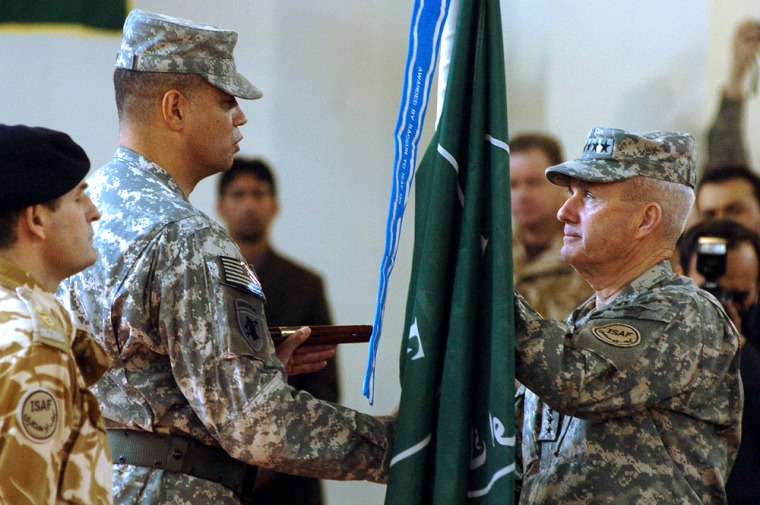Gen. Dan McNeill, the highest ranking U.S. general to lead troops in Afghanistan, took command of 35,500 NATO-led soldiers on Sunday, putting an American face on the international mission after nine months of British command.
The transition comes after a year of sharply increased violence following the alliance’s push into the Taliban’s southern heartland, and military officials said privately they expect McNeill to take a harder line with militants than his predecessor, Gen. David Richards.
Richards backed a peace deal in the southern town of Musa Qala that crumbled in his last days in command when an estimated 200 Taliban fighters overran the town on Thursday. NATO said a targeted airstrike Sunday killed a key Taliban leader causing the upheaval.
The appointment of McNeill, one of only 11 four-star generals in the Army, raises the profile of the American mission here two weeks after the Defense Department extended the tour of 3,200 10th Mountain Division soldiers.
Bolstered U.S. presence
There are now 26,000 U.S. troops in Afghanistan, the highest number ever. About 14,000 American forces fall under the command of NATO’s International Security Assistance Force; 12,000 troops focused on training Afghan forces and special operations fall under the U.S.-led coalition.
By comparison, there were only about 9,500 troops in Afghanistan in 2002, the year after the Taliban’s ouster.
Col. Tom Collins, an ISAF spokesman, said McNeill’s arrival and the increased troop levels underscored the American commitment.
AP: 4,000 died in violence in 2006
“Last year was a very tough year in Afghanistan and the enemy was able to make some gains in the south,” Collins said. “We have a lot of work that still needs to be done. ... It’s important we get more forces here. The United States has stepped up.”
McNeill takes command after a bloody 2006 in which insurgents launched a record number of suicide and roadside bombs. About 4,000 people died in insurgency-related violence last year, according to an Associated Press count based on numbers from U.S., NATO and Afghan officials.
McNeill — a veteran of five foreign conflicts, from Vietnam to Afghanistan, where he served in 2002-03 — said at a handover ceremony Sunday that ISAF’s mission was to facilitate reconstruction so Afghans “might enjoy self-determination, education, health and the peaceful realization of their hopes and dreams.”
“We will quit neither post nor mission until the job is done or we are properly relieved,” McNeill said.
Taliban chief slain in airstrike
Ninety minutes before the ceremony, a NATO airstrike killed a Taliban leader in Musa Qala, where an October peace deal between village elders and the Helmand provincial government prevented NATO, Afghan and Taliban fighters from coming within three miles of the town center.
Mohammad Wali, a Musa Qala resident, said the airstrike killed a militant named Mullah Abdul Gafoor and some of his associates while they were riding in a truck just outside Musa Qala. Collins did not name the person killed, saying officials wanted to be certain of his identify.
Another resident, Lal Mohammad, told The Associated Press on Saturday that the Musa Qala militants were being led by Gafoor, the hardline militia’s corps commander in western Afghanistan during the Taliban regime.
Musa Qala saw intense battles between Taliban fighters and British troops last summer and fall. The fighting caused widespread damage to the town of around 10,000 inhabitants, most of whom were forced to leave. British forces withdrew after the truce, which turned over security to local leaders.
Richards defended the deal on Saturday, saying it had caused a split between locals and Taliban fighters and that it was a classic tool of counterinsurgency warfare.
Richards oversaw NATO’s largest-ever ground battle, a fight in the southern district of Panjwayi in September that NATO says killed over 500 fighters. Military officials say the Taliban thought they could drive out NATO forces as they moved into the south.
The United States supplies the largest number of foreign troops backing the Afghan government of President Hamid Karzai, followed by Britain (5,200), Germany (3,000), Canada (2,500) and the Netherlands (2,200). Thirty-two other countries provide some troops.
